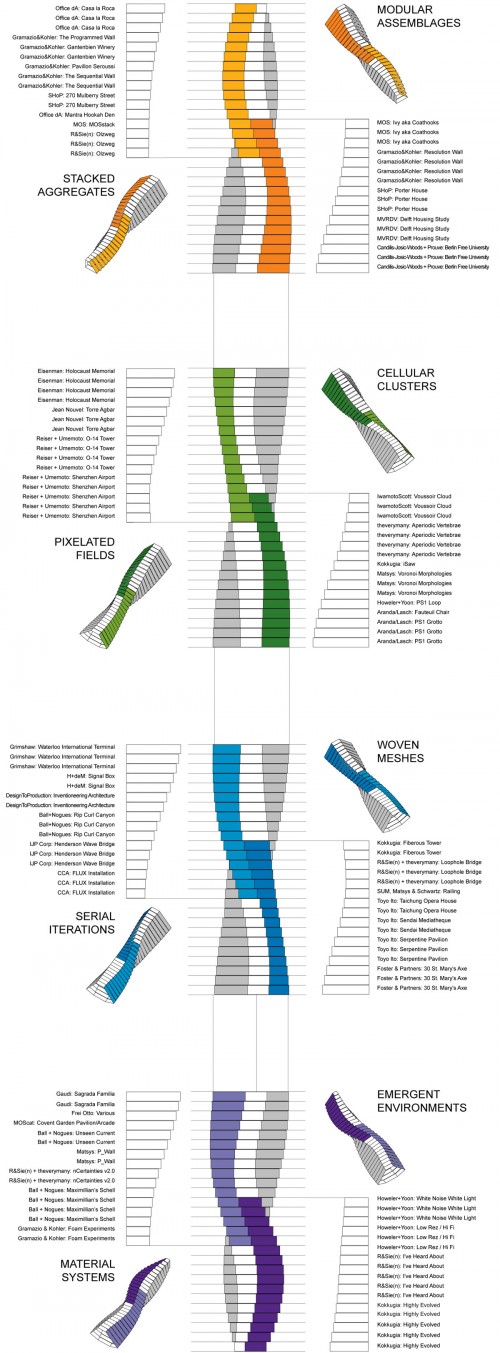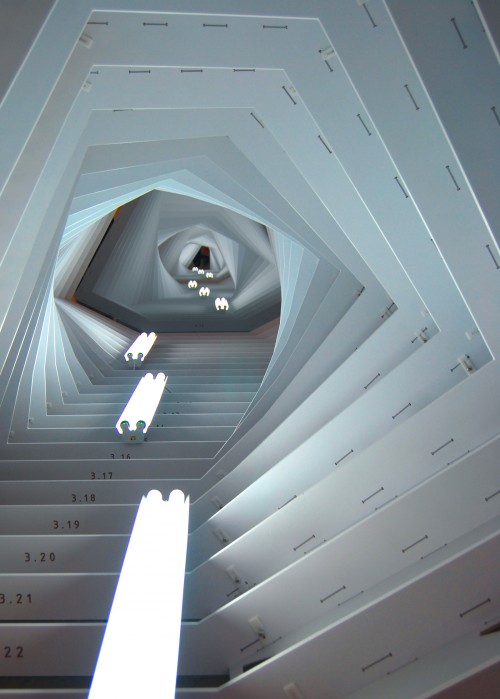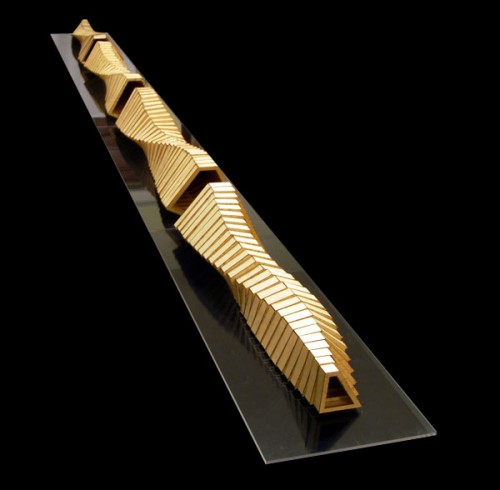


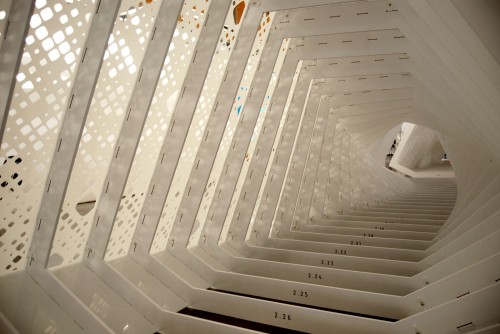

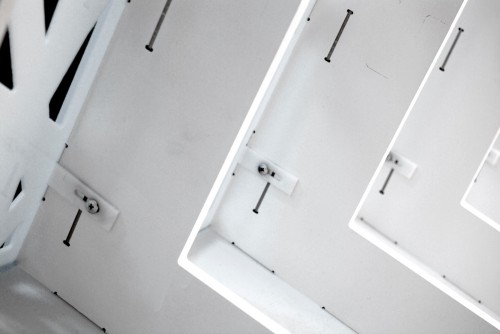
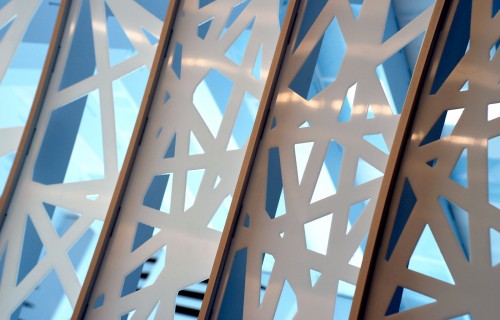
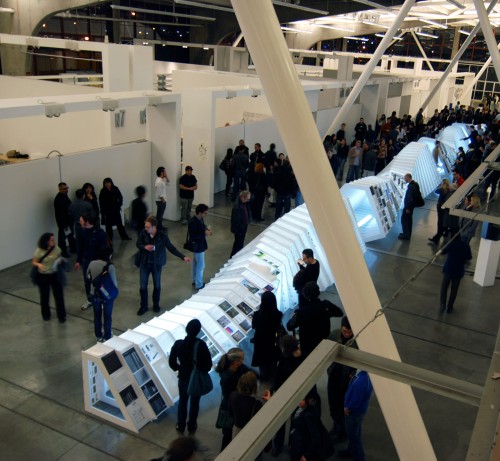


Architecture/MEDIAlab (see below for full credits)
Course: Generative Design, FLUX Advanced Studio, FLUX Fabrication Studio, Material Practice
Site: The Nave, California College of the Arts
Faculty:
Description: FLUX: Architecture in a Parametric Landscape by CCA Architecture/MEDIAlab is an exhibition that focuses on the emerging field of advanced digital design. In the last two decades of architectural practice, new digital technologies have evolved from being simply representational tools invested in the depiction of existing models of architectural space to becoming significant performative machines that have transformed the ways in which we both conceive and configure space and material. These tools for design, simulation, and fabrication, have enabled the emergence of new digital diagrams and parametric landscapes—often emulating genetic and iterative dynamic evolutionary processes—that are not only radically changing the ways in which we integrate disparate types of information into the design process, but are also significantly altering the methodological strategies that we use for design, fabrication and construction. After the early digital explosion of the 1990’s, new forms of rigor and production have entered into the field of architecture, supporting the emergence of parametric and building information modeling and the enhanced use of computational geometry and scripting that together represent the second critical wave of digital design practices. That our current models of space are far more continuous, variant and complex, is specifically a result of the tools we are using to produce them, an inevitable byproduct of the ever-expanding capacities of digital computation and related fabrication technologies as these intersect with theoretical trajectories that long ago dismantled the social, functional and technological truths of the early part of this century.
The FLUX exhibition was generated in conjunction with this year’s CCA Architecture Lecture Series focused on the integration of digital practices and design, CCA MEDIAlab’s digital workshops and the International Smart Geometry conference held in San Francisco in the spring of 2009. The content of the exhibition is organized through a series of thematic categories each of which explores a set of spatial logics that have been transformed through advanced digital practices: Stacked Aggregates, Modular Assemblages, Pixelated Fields, Cellular Clusters, Serial Iterations, Woven Meshes, Material Systems, and Emergent Environments. In this exhibit, these themes are elaborated through the presentation of 50 built works and experimental architectural projects, and are expanded by analytical diagrams and 3D printed models generated by CCA architecture students.
The FLUX installation, developed by a team of CCA faculty and students, also explores the possibilities of parametric modeling and digital fabrication through the production of the exhibition armature. Produced using CCA’s new CNC router and advanced parametric modeling techniques, the undulating structure expands and contracts as its volume extends down the center of the long nave space. Through the use of parametric modeling and a series of custom designed scripts, the installation design can be quickly updated to address new design criteria. From the thickness of the ribs to the overall twisting geometry and perforated skins, the spatial form of the armature is controlled through a complex set of relationships defined by its formal, performative, and fabrication constraints.
Official Credits
Architect: CCA Architecture/MEDIAlab
Location: San Francisco, United States
Date: 2008 – 2009
The FLUX installation, developed over 6 months by a team of CCA faculty and students, explores the possibilities of parametric modeling and digital fabrication at CCA. Produced using CCA’s brand new CNC router and advanced parametric modeling techniques, the structure undulates in plan and section producing a sense of expansion and contraction in the long Nave space. Through the use of parametric modeling and a series of custom designed scripts, the installation design can be quickly updated to address new design criteria. From the thickness of the ribs to the overall twisting geometry and perforated skins, the geometry is controlled through a complex set of relationships between its formal, performative, and fabrication constraints.
Director of Architecture: Ila Berman
Project Coordinator and Director of the MEDIAlab: Andrew Kudless
Installation Design: Kory Bieg, Andre Caradec, Andrew Kudless, Ila Berman
Exhibition Curation: Andrew Kudless with Ila Berman and Marc Fornes
Graphic Design Assistants: Jessica Gibson, Andy Payne, Melissa Spooner
Parametric Design Consultant: Andy Payne
Installation Team: Laurice der Bedrossian, Yoon Choi, Stephanie Close, Loi Dinh, David Garcia, Jessica Gibson, John Hobart-Culleton, Charlotte Hofstetter, Madaline Honig, Wayne Lin, Sandra Lopez, Mariko Low, Jen Melendez, Michelle Mucker, Andrew Peters, Jason Rhein, Ocean Rogoff, Angela Todorova, Dianne de la Torre, Michael Victoria, Olesya Yefimov
Graphic Design, Modeling and Scripting Team: Olutobi Adamolekun, Lynn Bayer, Ripon DeLeon, Anthony Diaz, Alexa Getting, Jessica Gibson, Noah Greer, Benjamin Harth, Madeline Honig, Elizabeth Jackson, Pouya Khakpour, Anna Leach, Ryan Lee, Charles Ma, David Manzanares Garcia, Ariane Mates, Andy Payne, Harsha Pelimuhandiram, Michael Perkins, Javier Rodriguez, Ricardo Ruiz, Melissa Spooner, Jessica Stuenkel, Vladimir Vlad, Duncan Young
Sponsors: SolidThinking, K Bieg Design, SUM Arch, Vogue Graphics
CNC Fabrication Support: Ryan Buyssens, Jo Slota
Consultation: Chris Chalmers, Andrew Sparks


